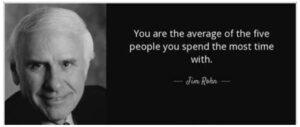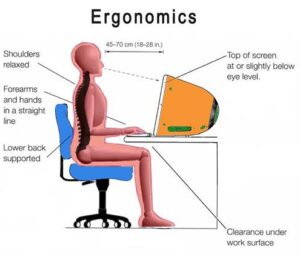The impact of environment on performance

As Jim Rohn famously said, “You are the average of the five people you spend the most time with.” And looking back on my life, I can say with certainty that this rings true.
During my school days at St. John’s Church High School in Secunderabad, I was fortunate to be surrounded by the best and brightest in my class. These were exceptional individuals with a drive to succeed that inspired me to do better. Their academic prowess and exceptional upbringing left an indelible mark on me, and I was able to excel both in my studies and in life.
However, my undergraduate years were spent in the company of brilliant but wayward peers. It was during this time that I learned the vices of smoking and drinking, and as a result, my academic performance suffered, and my personal life spiraled out of control. I was left with a mountain of debt and no direction in life.
This experience taught me a powerful lesson – the company we keep has a profound impact on our lives. The saying “birds of a feather flock together” holds true, and we must be mindful of the people we surround ourselves with. If we wish to be successful, we must seek out those who are already succeeding in their chosen fields, for it is only in their company that we can hope to elevate our own performance.
Indeed, the environment we find ourselves in can make all the difference in the world. It is up to us to choose wisely, to surround ourselves with people who inspire and motivate us to be the best versions of ourselves. So let us be mindful of the company we keep, for it is they who will shape the trajectory of our lives.
Introduction:
The environment we perform in can have a significant impact on our performance, whether it’s at work, school, or in sports. Factors such as lighting, noise, temperature, and ergonomics can all affect our ability to focus, concentrate, and perform at our best. In this module, we will explore each of these environmental factors in detail and provide strategies for optimizing one’s environment for peak performance.

Lighting:
Lighting is one of the most important environmental factors that can impact our performance. The right lighting can improve our mood, reduce eye strain and fatigue, and help us to concentrate better. On the other hand, poor lighting can cause headaches, eye strain, and affect our ability to focus.
In a study conducted by the American Society of Interior Designers, it was found that the quality of lighting in an office environment has a significant impact on employee productivity and satisfaction. In a well-lit environment, employees were found to be more productive, have fewer errors, and experience less eye strain.
In order to optimize one’s environment for peak performance, it’s important to ensure that the lighting is adequate and appropriate for the task at hand. For example, bright overhead lighting may be appropriate for a busy office environment, while softer, dimmer lighting may be more appropriate for a relaxed, creative environment.
Noise:
Noise is another environmental factor that can impact our performance. Loud or distracting noises can cause stress, reduce concentration, and affect our ability to perform well. On the other hand, certain types of background noise, such as music, can improve our mood and increase our productivity.
In a study conducted by the University of British Columbia, it was found that moderate noise levels can enhance creativity, while high noise levels can impair it. The study found that a moderate level of noise, such as the background noise in a coffee shop, can increase creativity by stimulating the brain’s processing power.
To optimize one’s environment for peak performance, it’s important to consider the type and level of noise in the environment. For example, playing calming music or white noise may help to reduce distracting noises in a busy office environment and improve concentration.
Temperature:
Temperature is another important environmental factor that can impact our performance. Extreme temperatures, whether hot or cold, can cause discomfort, reduce focus, and impair our ability to perform well. The optimal temperature for peak performance varies depending on the task at hand.
In a study conducted by Cornell University, it was found that the optimal temperature for office productivity is between 71-77 degrees Fahrenheit. Temperatures outside of this range were found to reduce productivity and increase errors.
To optimize one’s environment for peak performance, it’s important to ensure that the temperature is appropriate for the task at hand. For example, a cooler temperature may be more appropriate for a physically demanding task, while a warmer temperature may be more appropriate for a creative task.
Ergonomics:
Ergonomics refers to the design and arrangement of furniture and equipment to optimize human performance and prevent injury. Poor ergonomics can cause discomfort, pain, and reduce productivity, while proper ergonomics can improve comfort, reduce strain, and increase performance.

In a study conducted by the National Institute for Occupational Safety and Health, it was found that proper ergonomic design can reduce the incidence of musculoskeletal disorders and improve productivity.
To optimize one’s environment for peak performance, it’s important to consider ergonomic design when selecting furniture and equipment. For example, an ergonomic chair with adjustable height and lumbar support can reduce back pain and improve posture, while an ergonomic keyboard and mouse can reduce strain on the hands and wrists.
A poorly designed workspace can cause discomfort, pain, and even long-term health problems. On the other hand, a well-designed workspace can increase productivity and reduce the risk of injury.
For example, a computer user who spends long hours at their desk may experience discomfort or pain in their neck, back, or wrists. This is often caused by poor posture, improper keyboard or mouse placement, or a poorly designed chair. By making adjustments to the height of the desk and chair, using an ergonomic keyboard and mouse, and taking regular breaks to stretch, the user can reduce discomfort and improve their productivity.
Similarly, athletes must have access to well-designed equipment that is properly maintained. For example, a runner who trains on a treadmill with a worn-out belt is at risk of injury. The friction between the foot and the belt can cause blisters or even lead to falls. Proper maintenance and replacement of equipment is essential to ensure that athletes can train safely and effectively.
In addition to physical factors, the social and cultural environment can also have an impact on performance. For example, the presence of supportive and encouraging teammates can boost an athlete’s confidence and motivation. On the other hand, a negative or unsupportive team culture can undermine an athlete’s performance and confidence.
The cultural environment can also influence performance. For example, research has shown that stereotypes and biases can affect how people perceive their own abilities and potential. If an individual belongs to a group that is stereotyped as being less competent or successful in a particular field, they may internalize these stereotypes and perform worse than they would if they did not have these negative beliefs.

In conclusion, the environment in which one performs can have a significant impact on their performance. By optimizing environmental factors such as lighting, noise, temperature, and ergonomics, individuals can improve their productivity and reduce the risk of injury. Additionally, by promoting a supportive and positive social and cultural environment, individuals can boost their confidence and motivation, leading to even better performance.
 Dr K. Jayanth Murali is a retired IPS officer and a Life Coach. He is the author of four books, including the best-selling 42 Mondays. He is passionate about painting, farming, and long-distance running. He has run several marathons and has two entries in the Asian book of Records in full and half marathon categories. He lives with his family in Chennai, India. When he is not running, he is either writing or chilling with a book.
Dr K. Jayanth Murali is a retired IPS officer and a Life Coach. He is the author of four books, including the best-selling 42 Mondays. He is passionate about painting, farming, and long-distance running. He has run several marathons and has two entries in the Asian book of Records in full and half marathon categories. He lives with his family in Chennai, India. When he is not running, he is either writing or chilling with a book.
